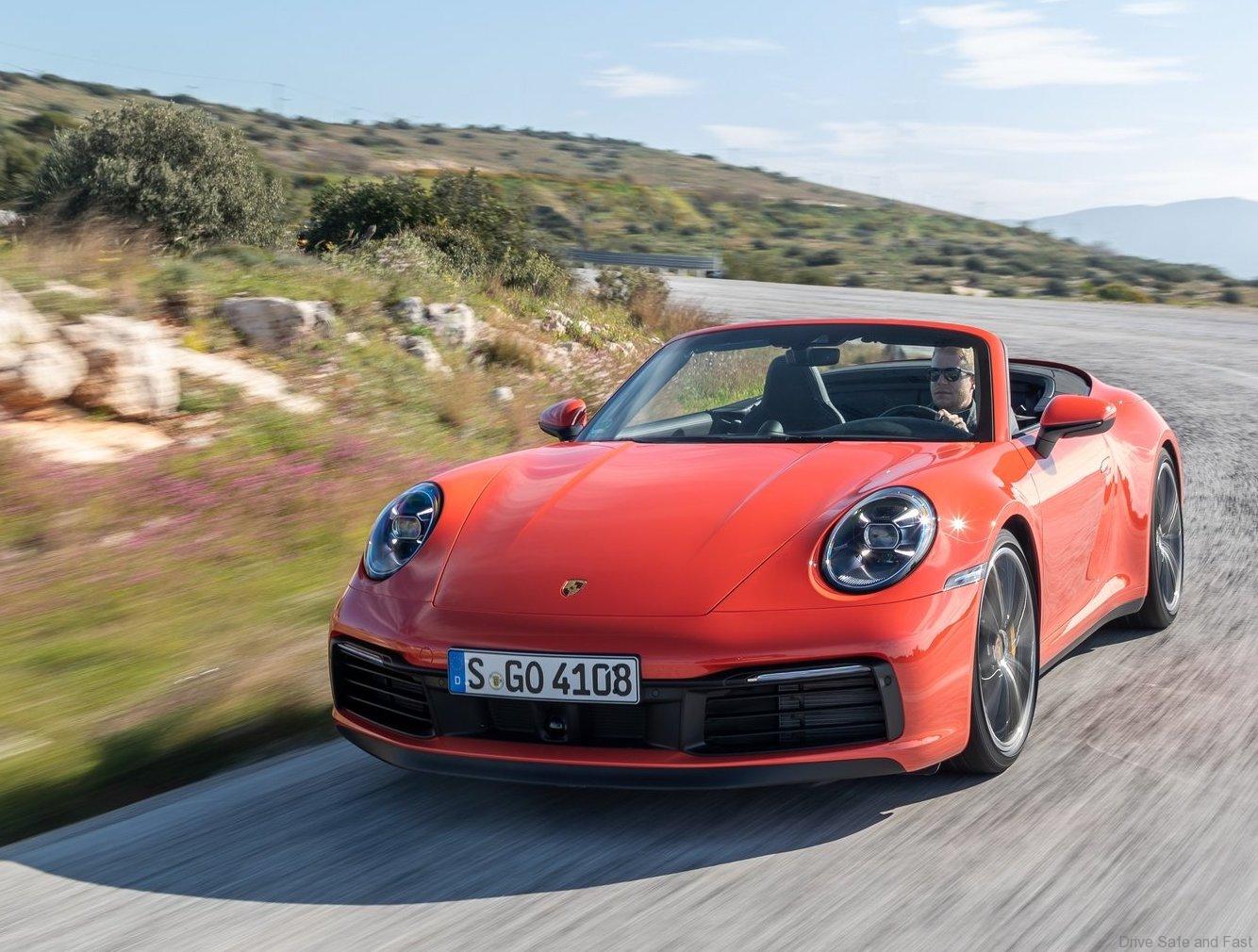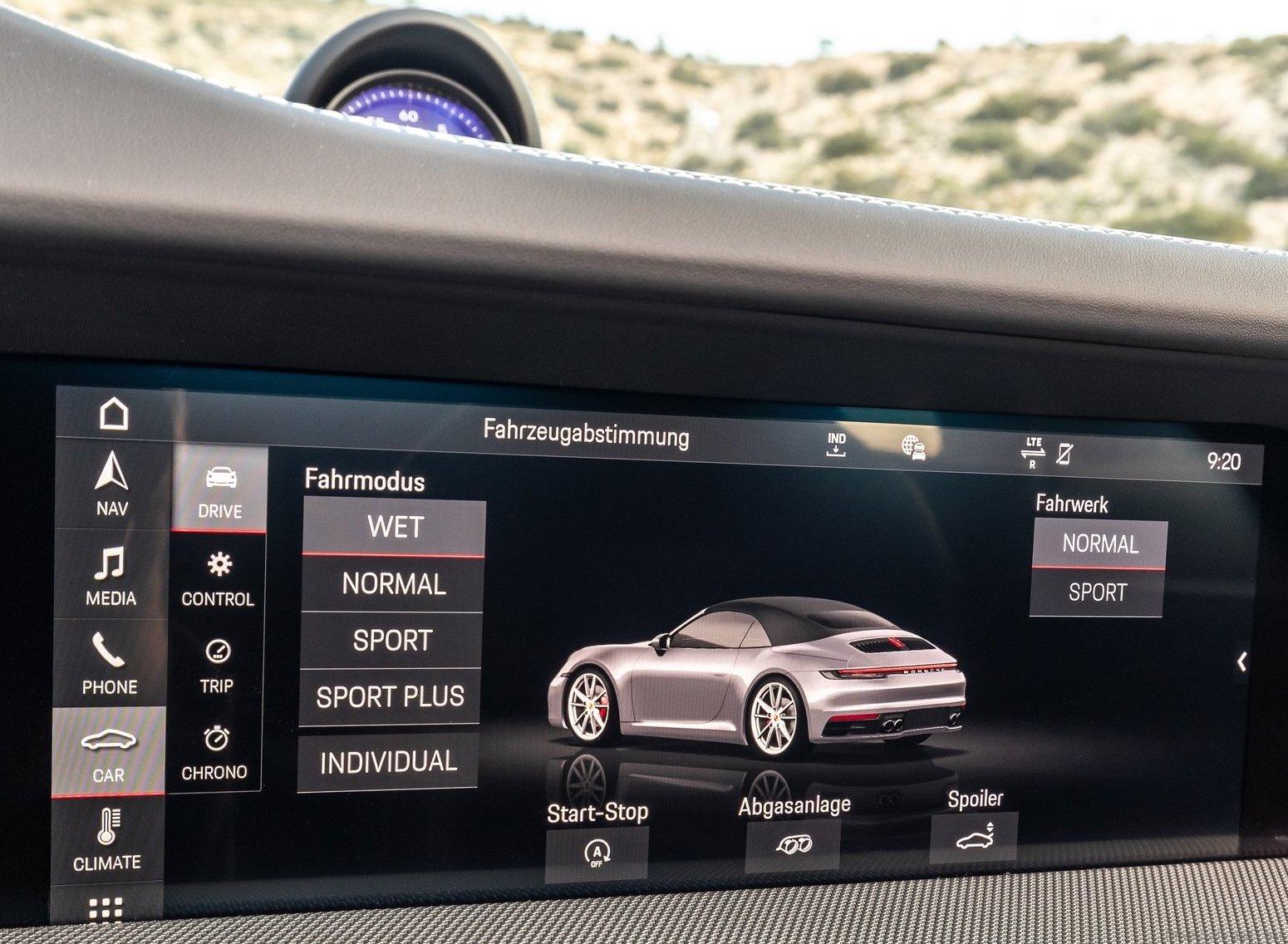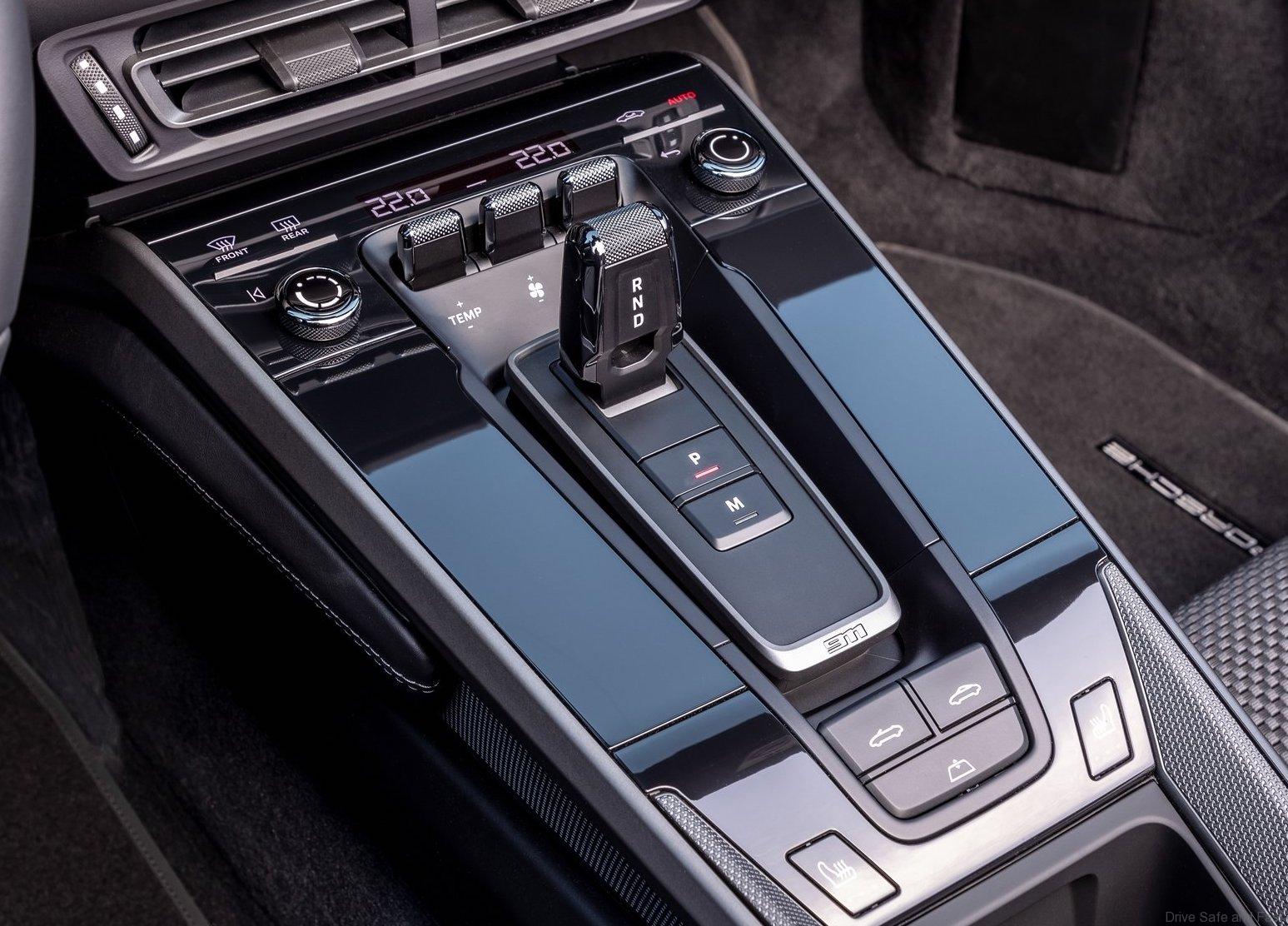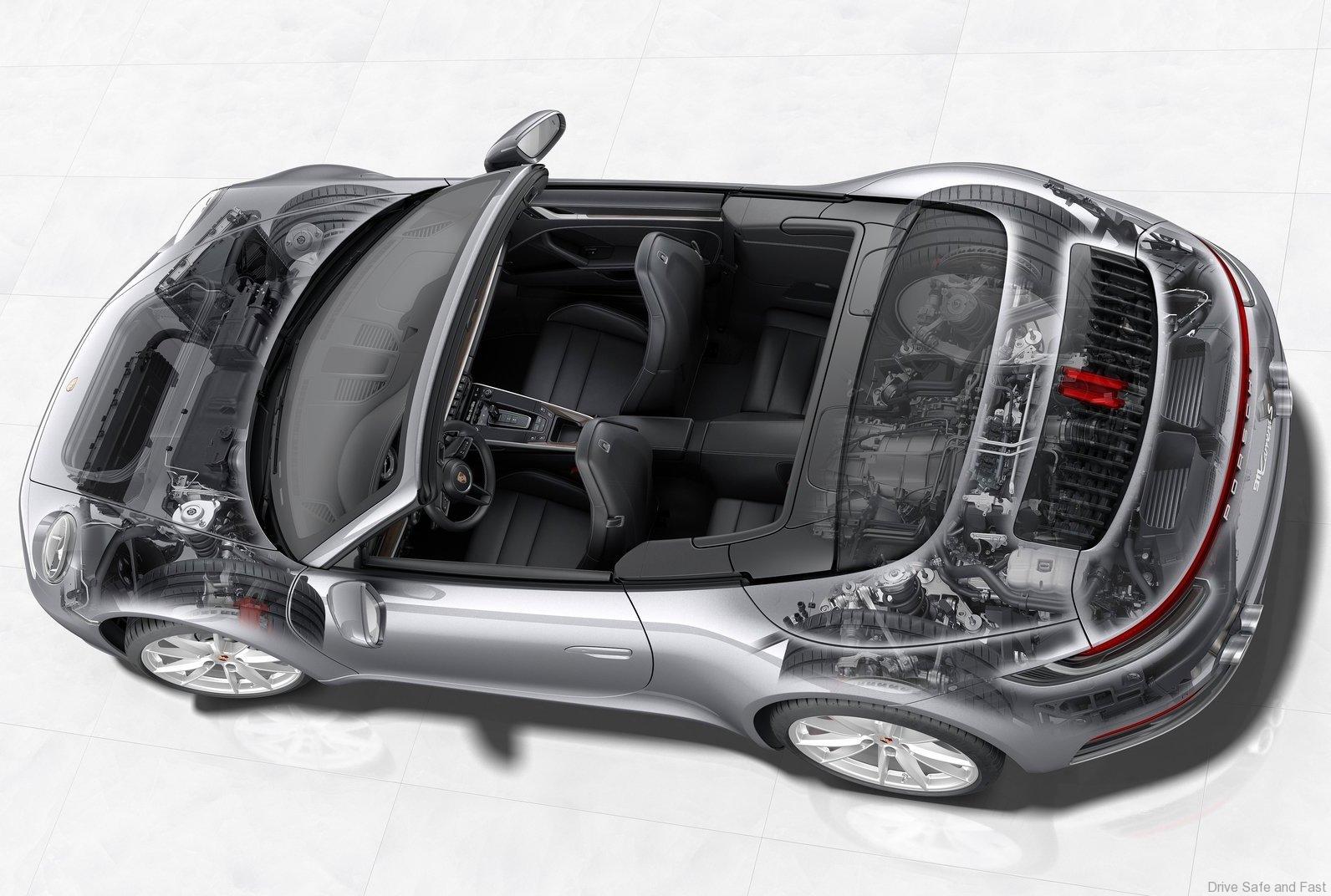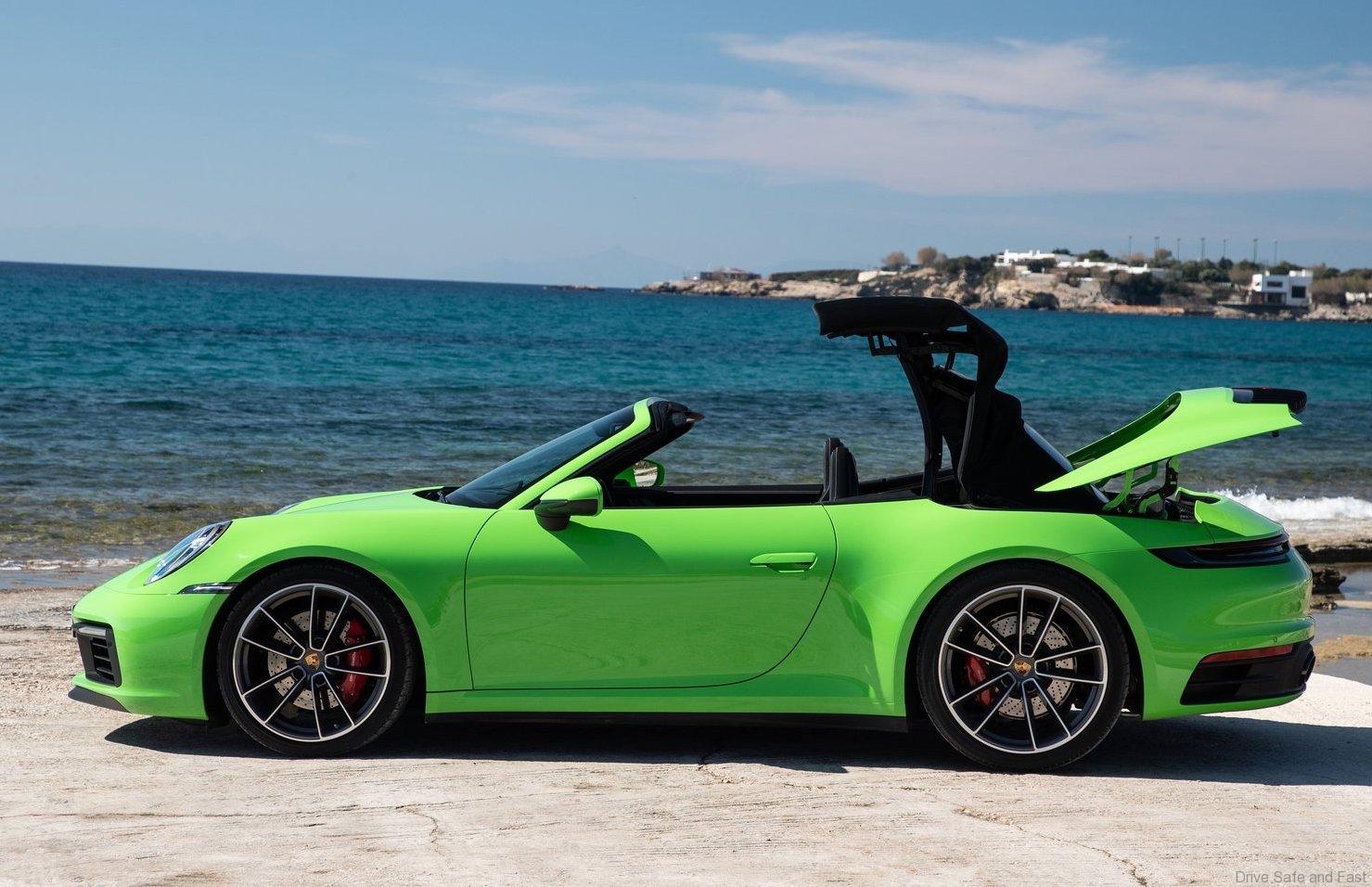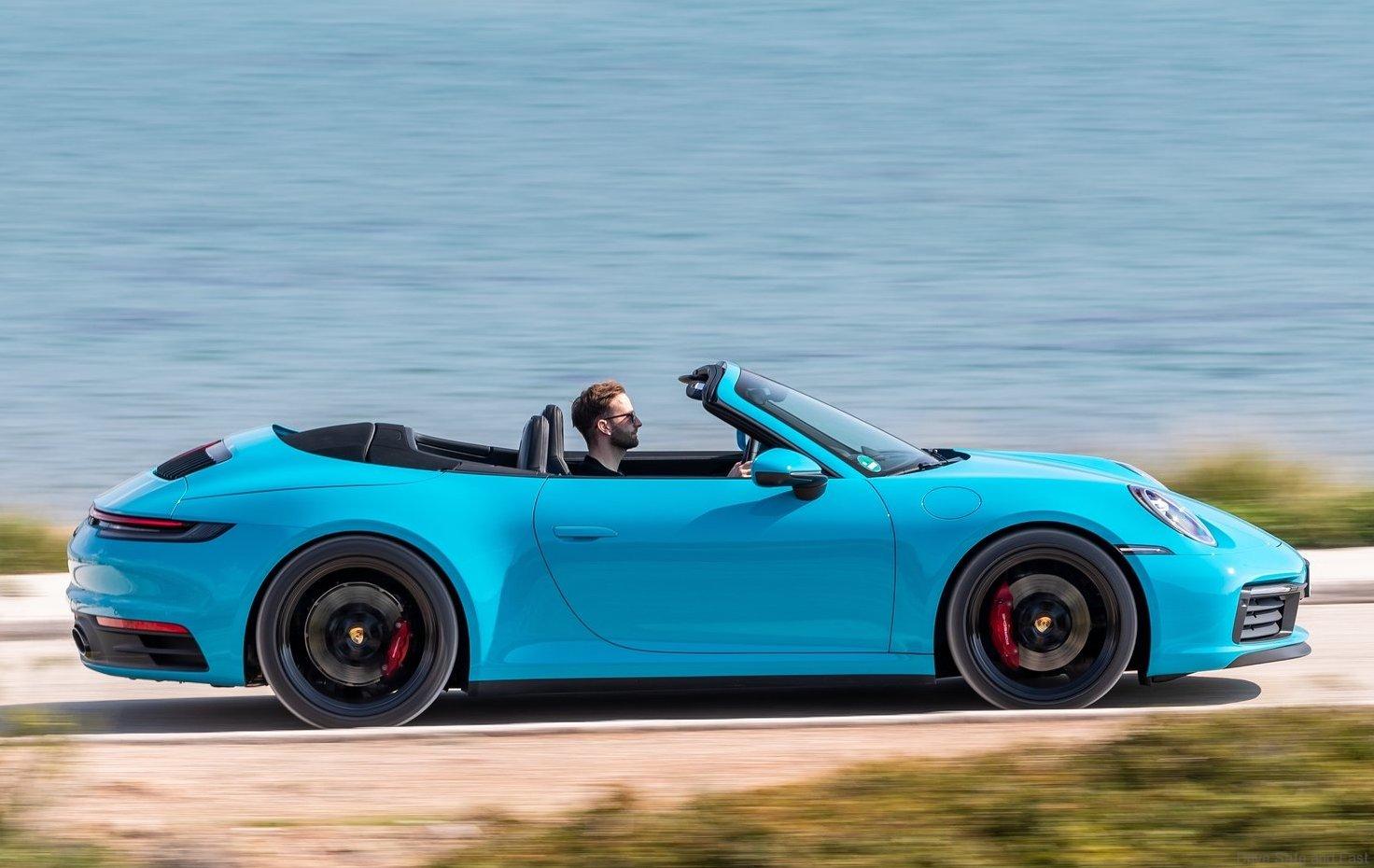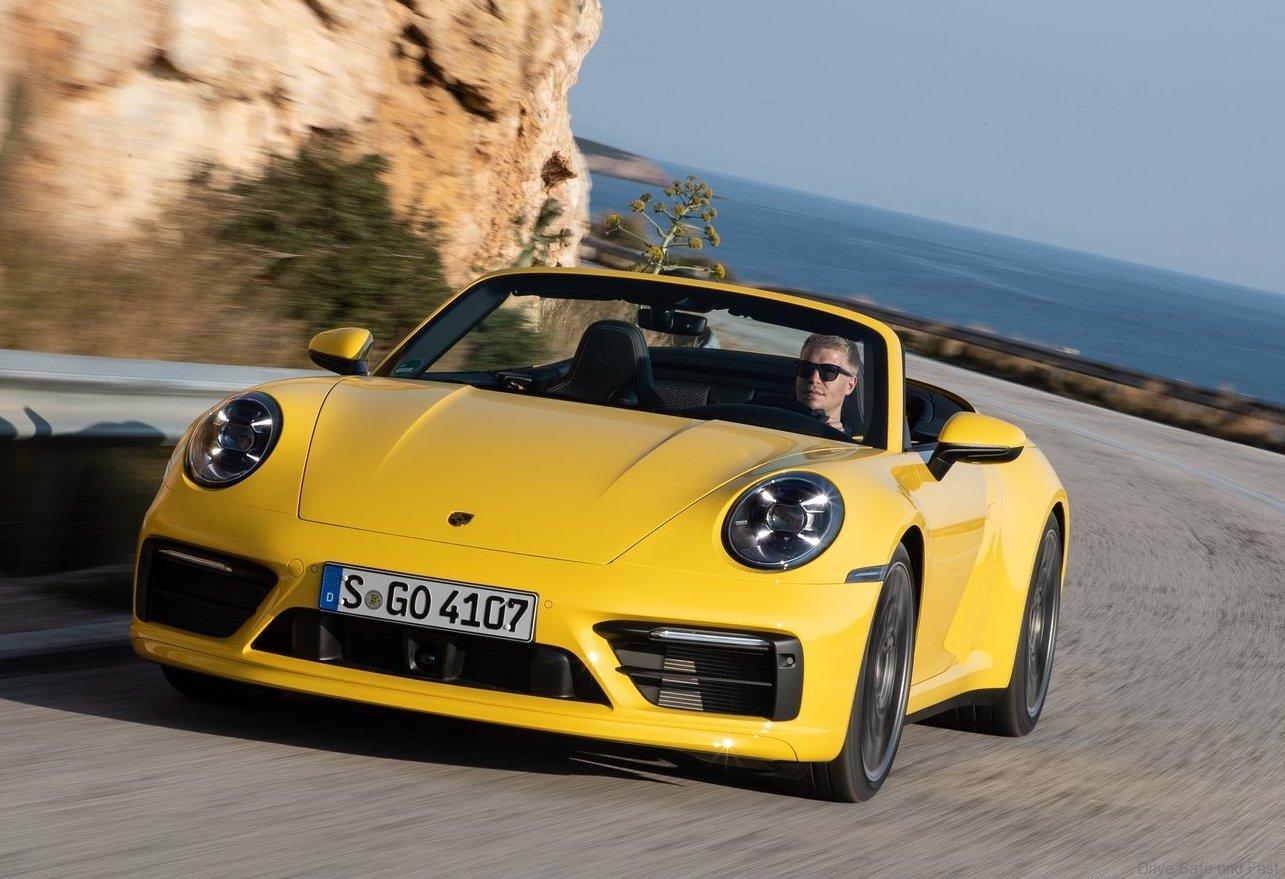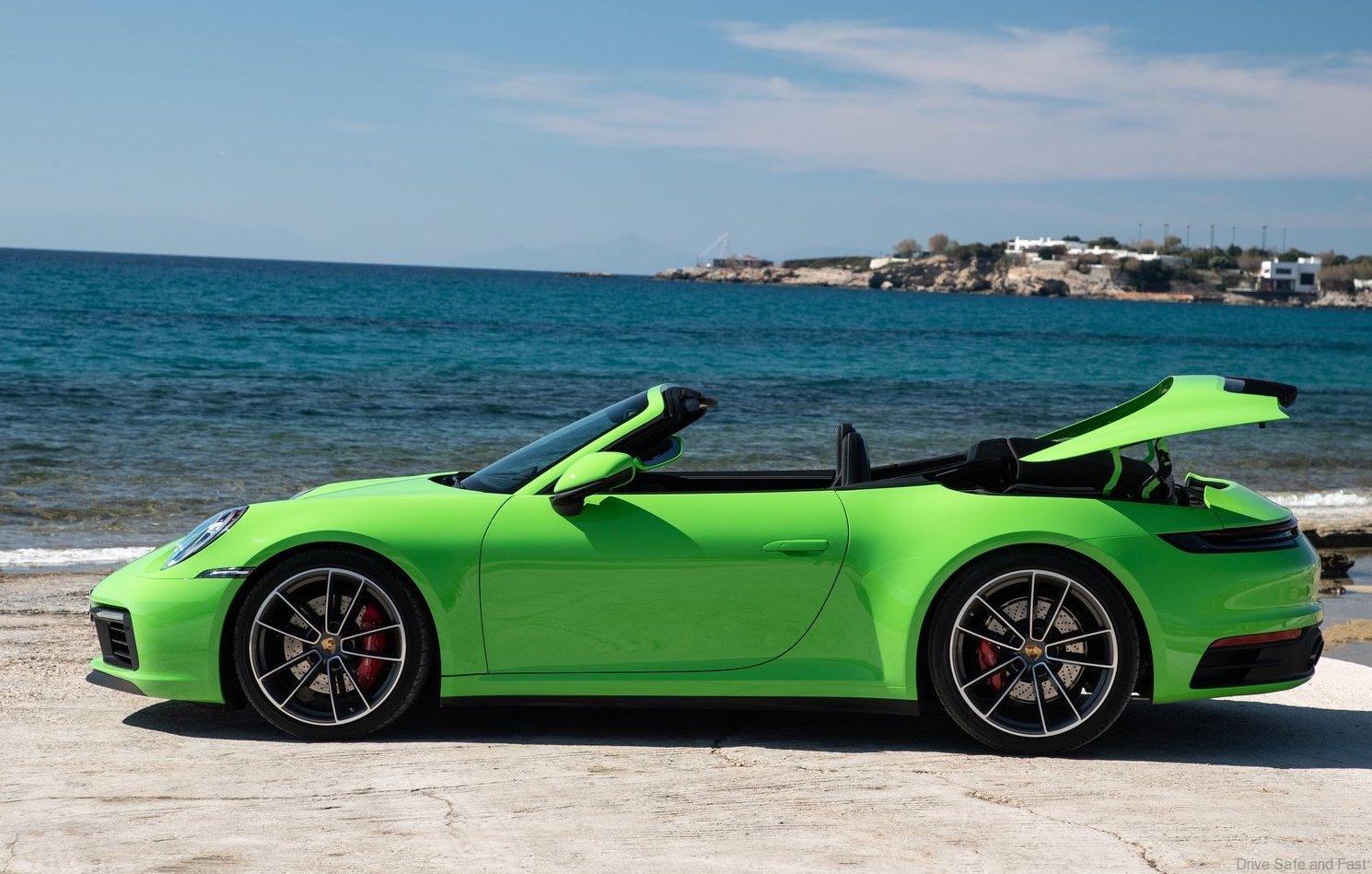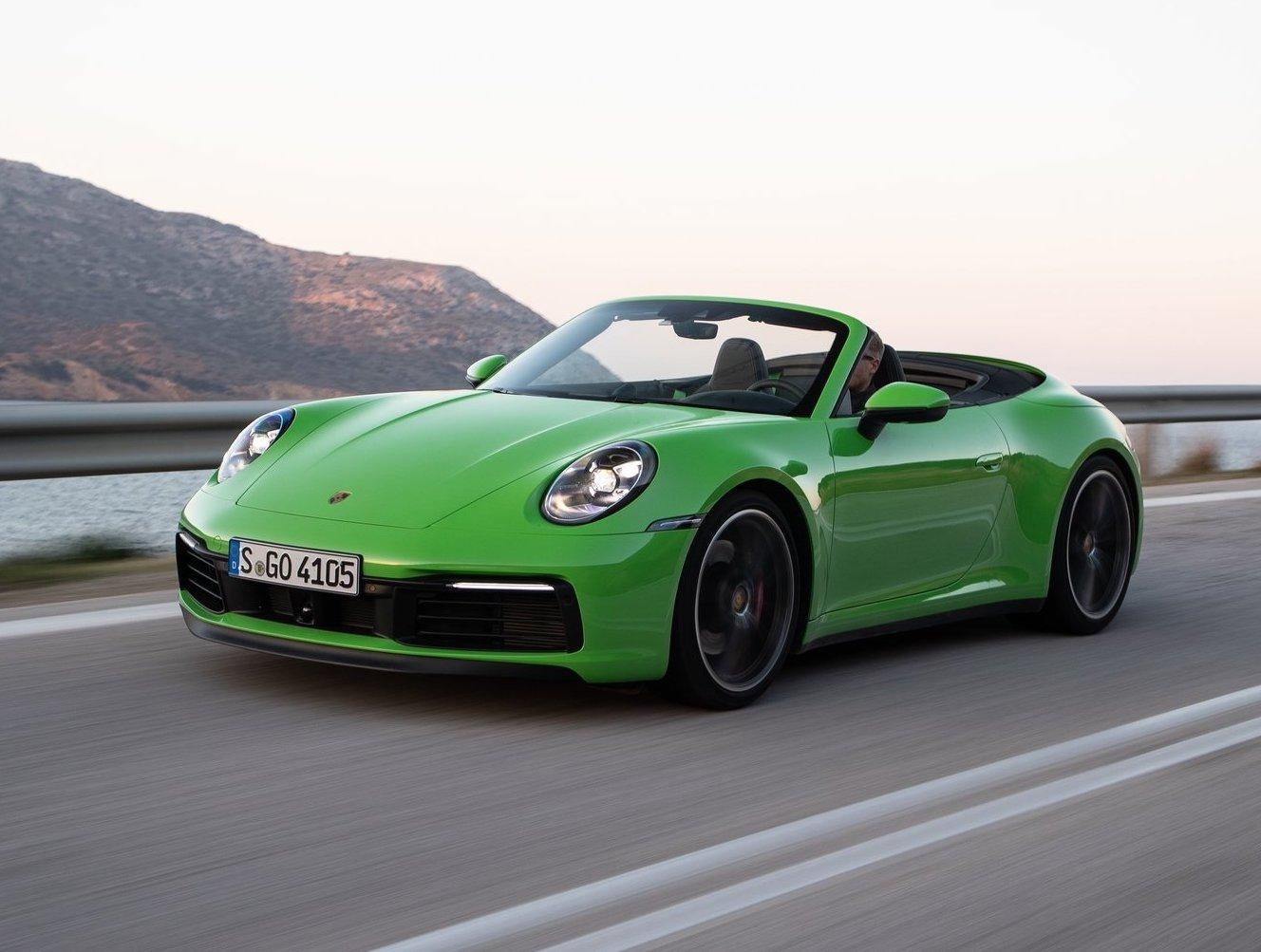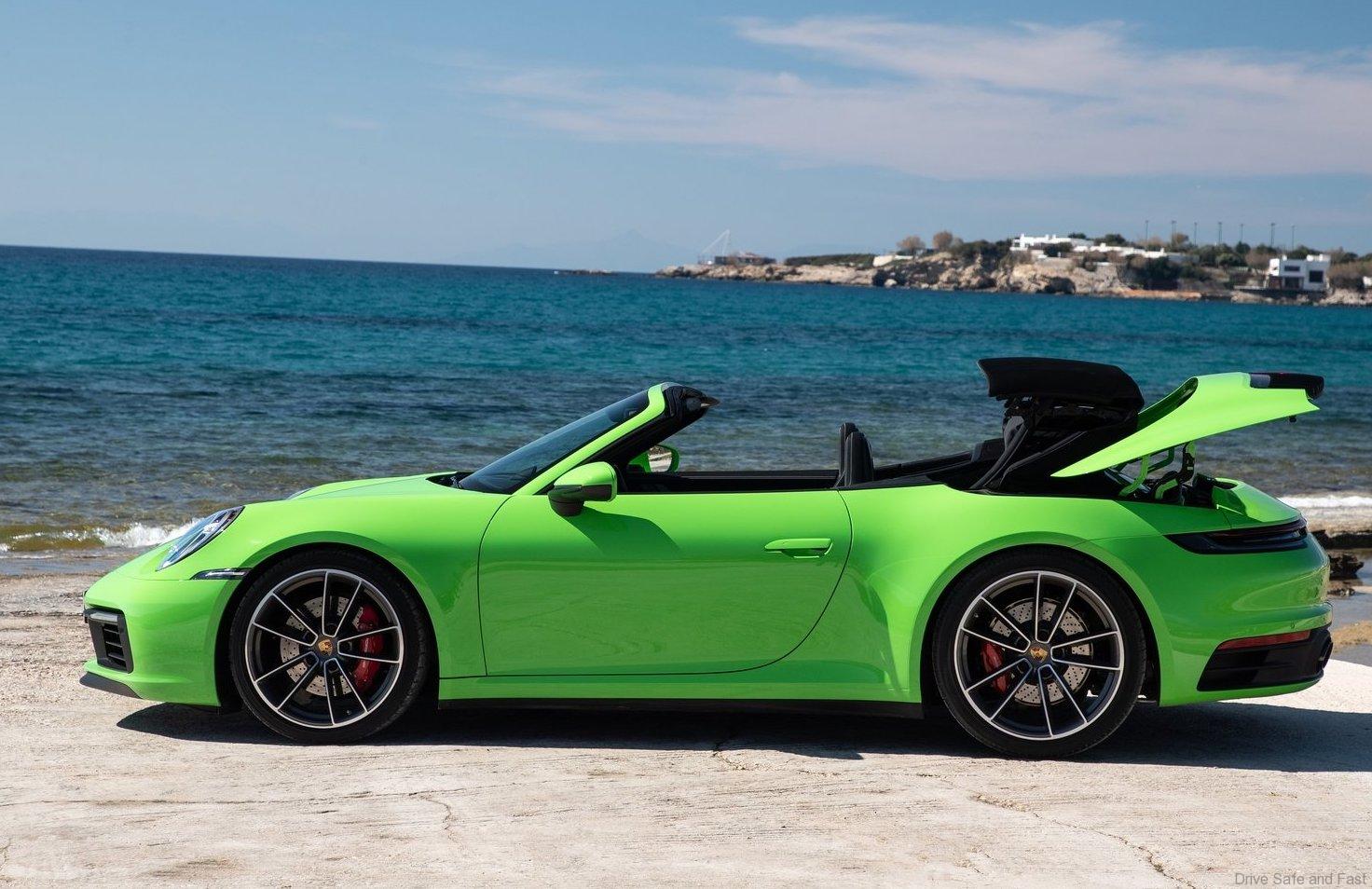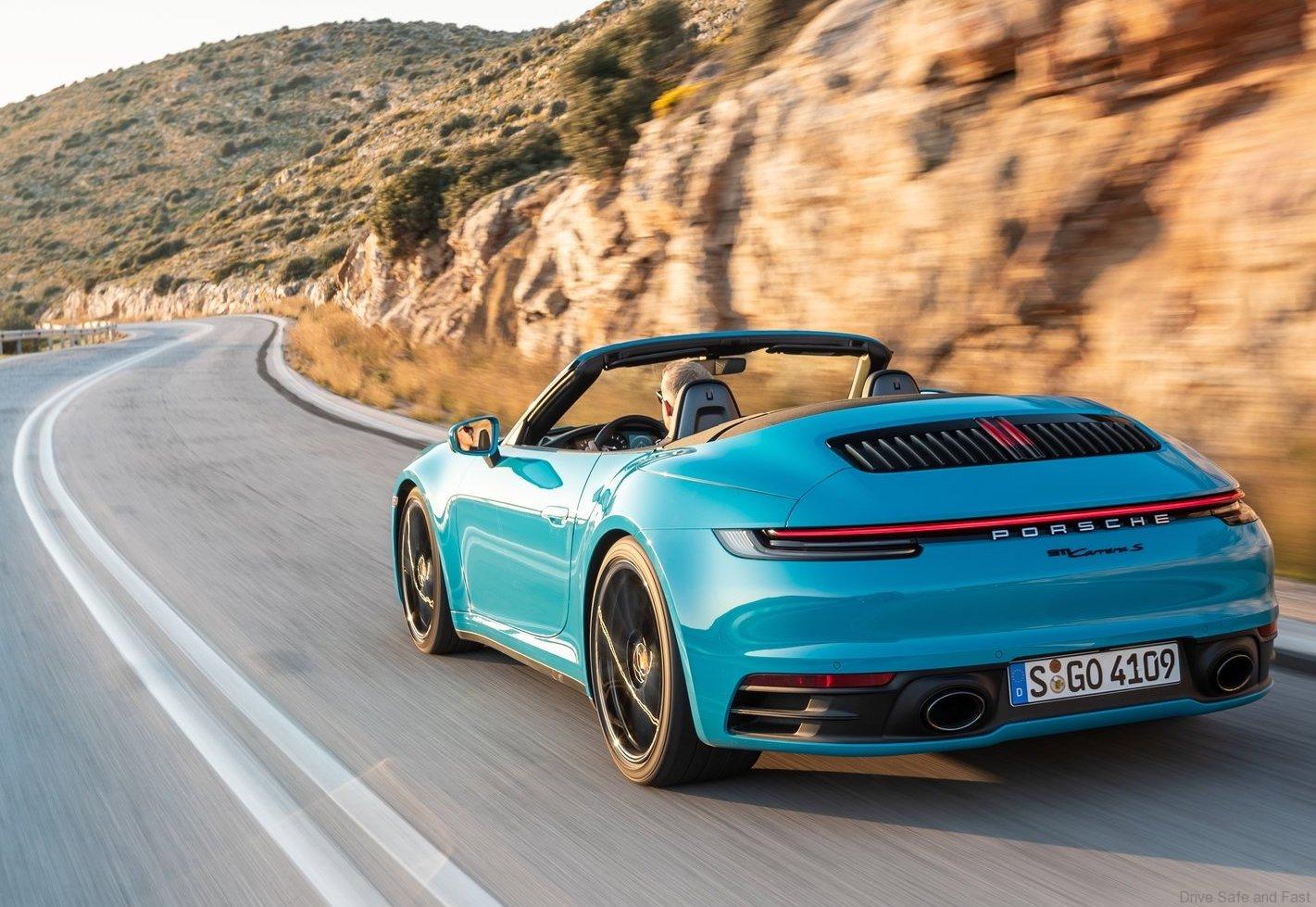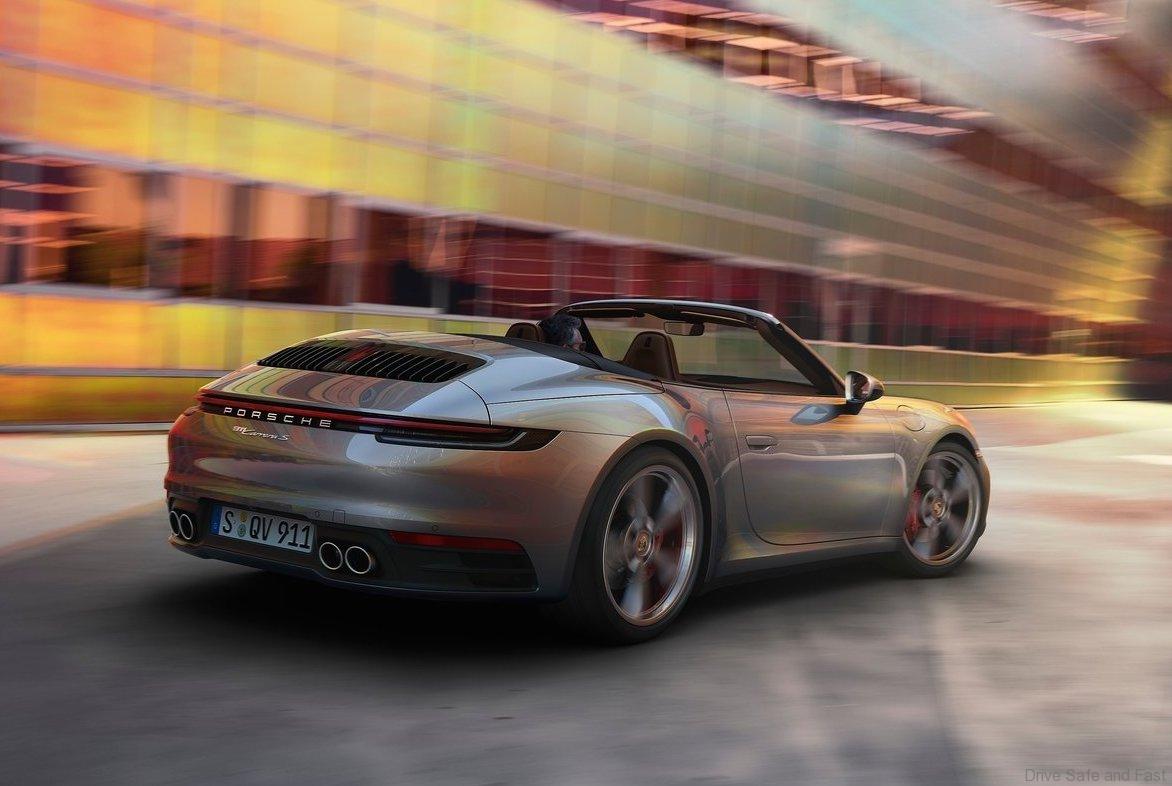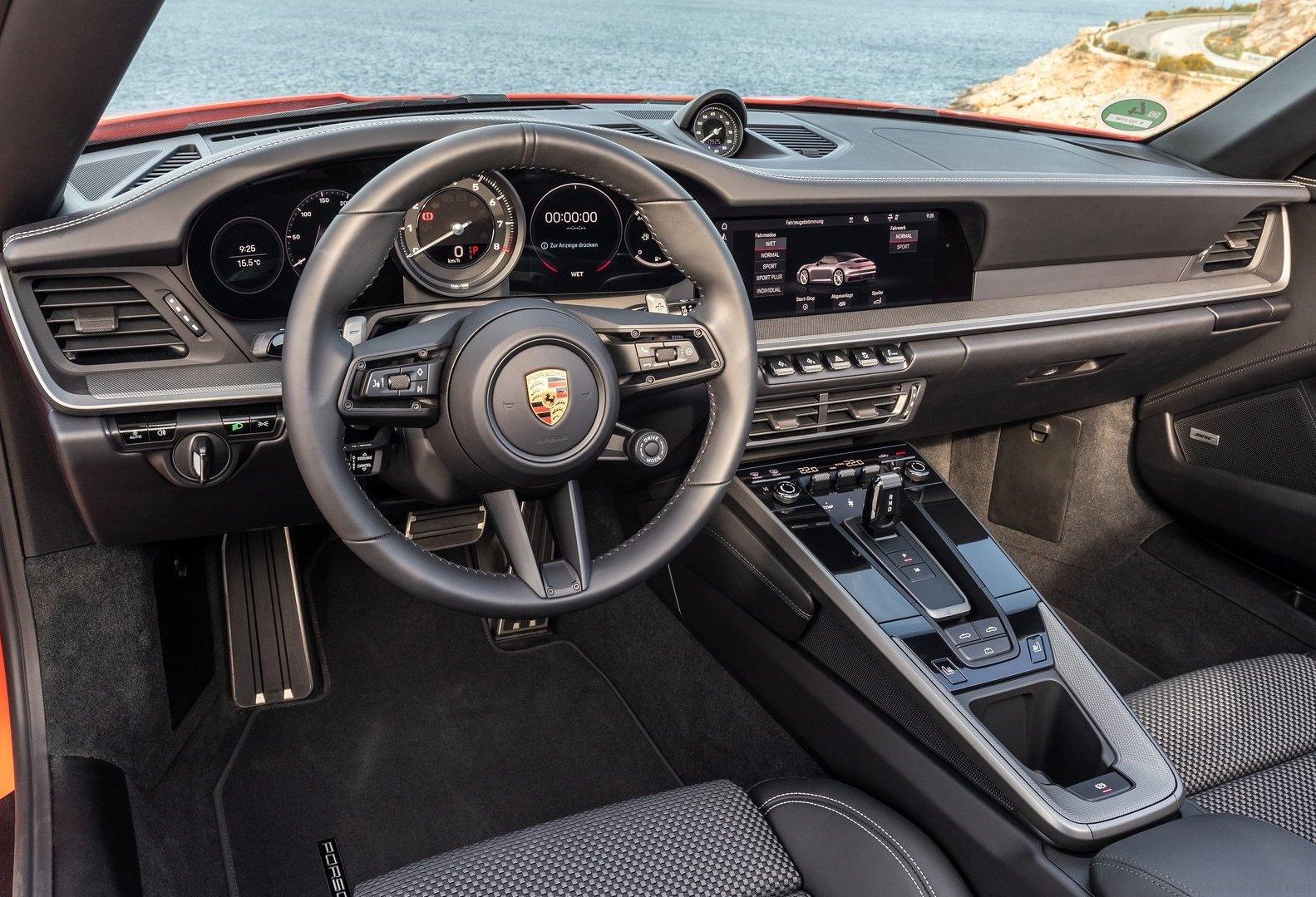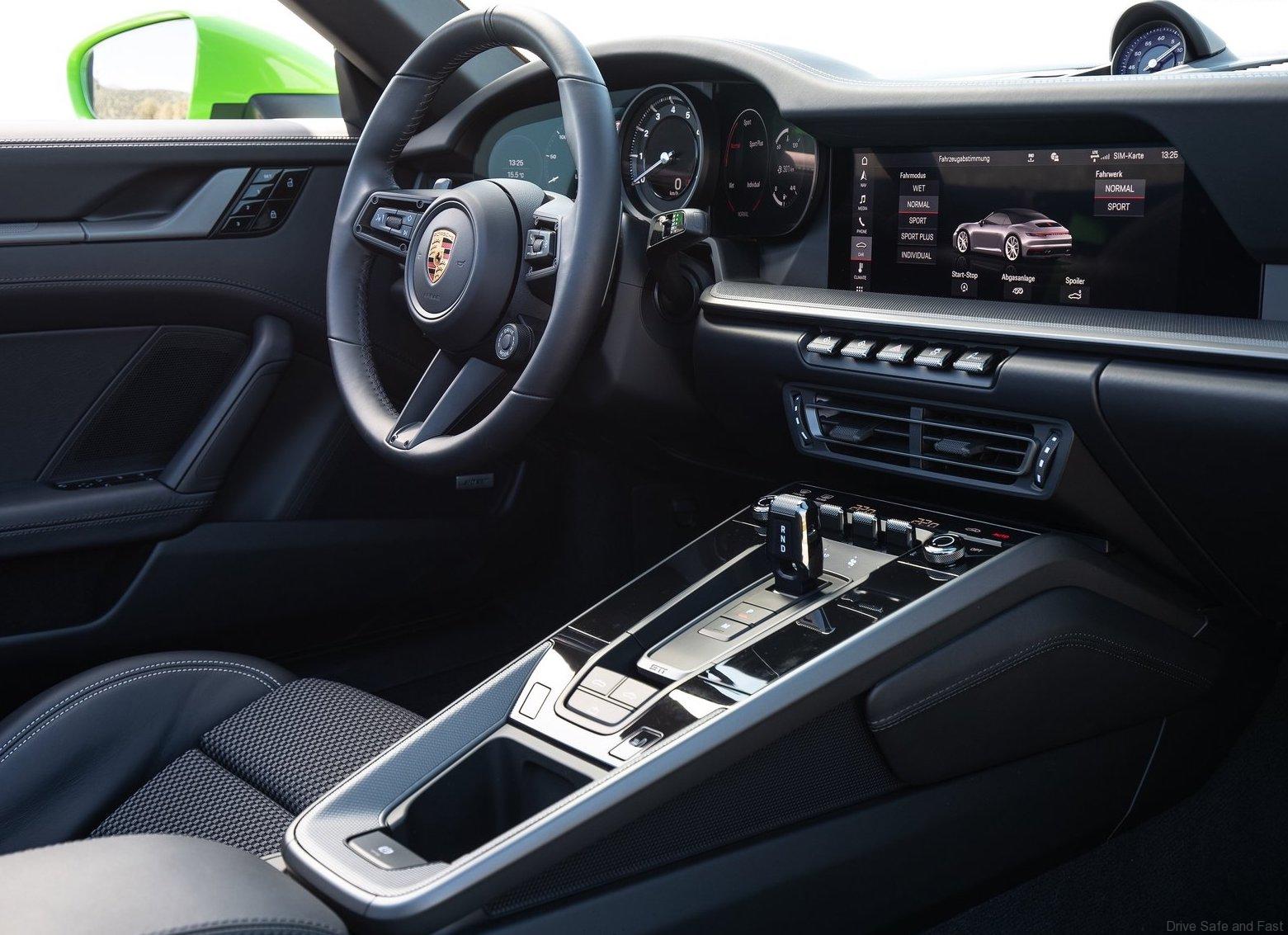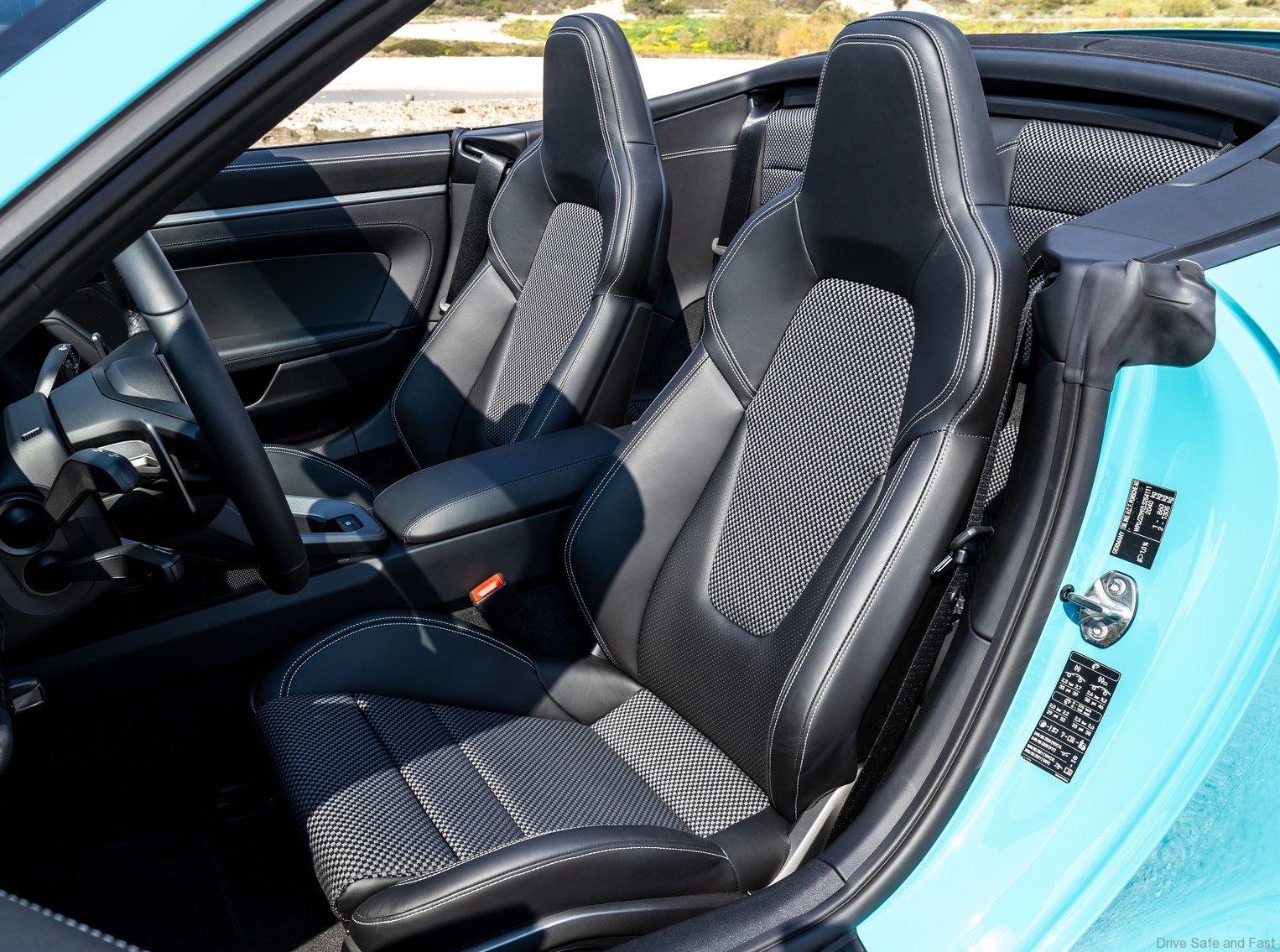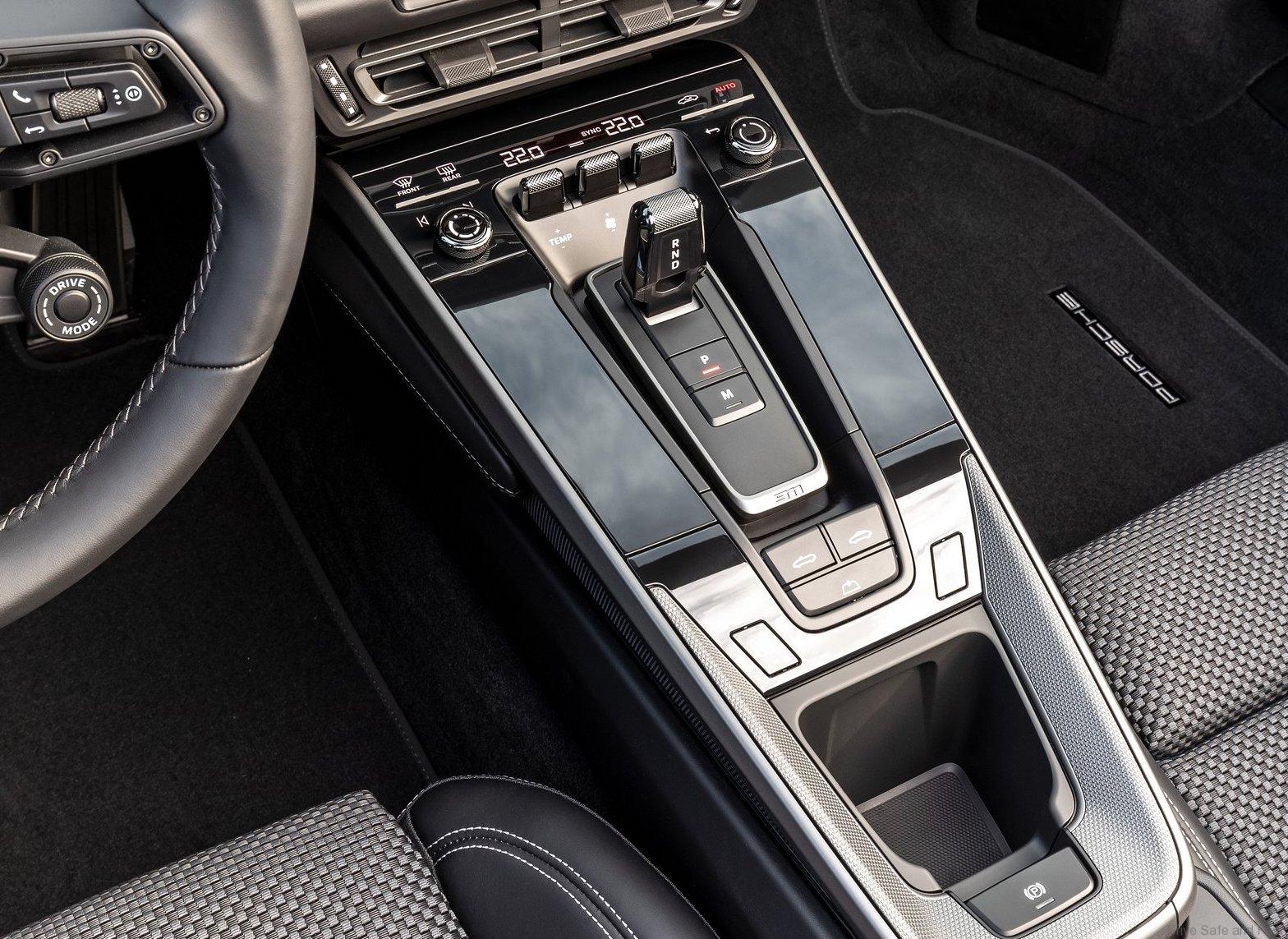The first Porsche sports car from 1948, the 356 “No. 1” Roadster had an emergency convertible top. Up to the presentation of the first 911 generation at the International Motor Show (IAA) in Frankfurt in 1963, open-top variants of the Porsche 356 were popular models in the vehicle range. However, when developing the original 911, the team first concentrated on the Coupé. Initial draft designs for an open-top variant from chief designer Ferdinand Alexander Porsche then already showed removable roof sections like those used in the 911 Targa in a further developed form.
This 911 version was also known as the “safety cabriolet” and made its debut in 1965, also at the IAA in Frankfurt, with a 20-centimetre wide roll-over bar, removable roof section and a rear fabric top. This was known as the soft window. This was followed shortly afterwards by a panorama rear window with heatable glass. The name of the open-top variant – “Targa” – is derived from Targa Florio endurance race on Sicily that Porsche had already won five times. Delivery to customers took place from January 1967 onwards. A further 14 years then passed until the first presentation of a 911 Cabriolet study. Porsche presented a Cabriolet prototype only in 1981, again at the IAA. This was additionally equipped with all-wheel drive and a wide Turbo body. In March 1982, the series-production version finally made its debut at the Geneva Motor Show, the 911 SC Cabriolet.
Now for 2019 here comes a brand new Porsche 911 Carrera Cabriolet offers unfiltered driving pleasure. The fresh-air version of the eighth 911 generation is now being launched just four months after the world premiere of the Coupé. The Cabriolet is a model with particular importance for the sports car manufacturer: this is because the first Porsche sports car, the 356 “No. 1” Roadster from 1948, was an open-top car. Its convertible top was made of simple canvas. Full-featured Cabriolet versions have also enhanced the 911 family since 1982 – and have been equipped with electrically operated high-tech roofs since 1987.
The new Porsche 911 Carrera S Cabriolet is equipped with the most technically advanced roof design that Porsche has to offer. The electrohydraulic system is now even lighter and closes the fabric hood in just twelve seconds, and can even do this while driving up to speeds of 50 km/h. The integrated wind deflector also extends electrically in two seconds and calms the air movement in the interior.
The new Cabriolet offers pure pleasure even when the top is closed: the squat roofline mirrors the unmistakable silhouette of the Coupé. At the same time, special magnesium panel bows prevent the soft top from ballooning when driving at high speed and also offer optimum protection for the vehicle occupants. The heated glass rear window improves all-round visibility, while the automatic roll-over protection system increases safety. An additional layer made of heat- and noise-insulating material ensures comfort in all weather.
Press Released Here: The new 911 is wider, more self-confident and more muscular. The contours are familiar and unmistakably based on the Porsche design DNA, but are nevertheless still strikingly new. The dimensionally stable fabric hood of the Cabriolet does nothing to change that. It picks up the roof contour, the so-called flyline, and continues it to the rear of the vehicle. The fabric hood is available in a choice of colours: black, dark-blue, brown and red. Standard new LED headlights and a bonnet in the style of earlier 911 generations combine future-oriented design elements with further-developed features that are typical for the brand. The new 911 models have an even more distinctive appearance with up to 45-millimetre wider wings and larger wheels on the rear axle. The vehicle width is emphasised by the newly structured rear end with new, continuous LED light bar and a distinctive third brake light.
Bonnet in the style of the G series
The front end revives a traditional feature of earlier 911 models from the G series: a forward-extended bonnet with a distinctive recess in front of the windscreen. Both elements lengthen the front of the vehicle and provide it with a dynamic look. At the same time, the completely newly developed LED headlights demonstrate the technological progress of the 911. They are integrated into the wings almost seamlessly with the typical 911 round and upright form. The design of the optional LED matrix headlights in particular is a visual highlight and is customised to the technology used in them. The optimised daytime running lights ensure that the 911 has an even more imposing presence.
Wide body with smooth surfaces
With an unchanged wheelbase, the new 911 is now 20 millimetres longer, but is above all much wider: 45 millimetres at the front axle on all models and 44 millimetres at the rear axle of the Carrera S. The new 911 therefore again seems flatter, particularly when viewed from the front. The modern, straight lines of the front end are continued consistently in the side view. The door gives the impression of having been inserted seamlessly between the front and rear wings. With linear contours, it is integrated into the side without any frills. The sweep of the side contour starts lower down than on the previous model to create a visually lower centre of gravity and thus underlines the squat appearance of the new 911. The wheels on the rear axle are one inch larger and therefore emphasise this further. Flush door handles, which pop out electrically when approached, and a rectangular, aerodynamically enhanced exterior mirror design complete the calm, powerfully modelled vehicle side. The exterior mirrors have also been redesigned and optimised to minimise wind noise. They can also optionally be folded in electrically. The standard black lower mirror trim is also available in the vehicle colour as an option.
Rear end with new LED light bar
With its pronounced recessed contours and low apron termination, the rear end is an archetypal feature of the 911. It is functionally divided into three elements on the Cabriolet: the multi-part convertible top structure is folded in Z-form under the electrically opening rear lid. The large rear spoiler has been adapted to the lid shape. The entire rear end is largely the same as on the Coupé. The new, one-piece LED light bar and the number plate positioned low down produce a dramatic look and clearly differentiate the new generation from the predecessor models. The vertically arranged louvres of the air intake echo the contours of the rear window. On the Cabriolet, the distance between the air intake and window is slightly larger than on the Coupé due to the new rear lid design. The centrally located third brake light has been integrated into the intake louvres. Since this is hidden when the rear spoiler is extended, a second brake light has been incorporated in the spoiler.
As a distinguishing feature, the rear-wheel-drive models have black louvres, while the all-wheel-drive models have chrome elements in the rear grille. The rear spoiler is positioned directly below the air intake and is significantly wider. It now extends almost to the outer edge of the tail lights.
The new continuous LED light bar immediately catches the eye at the rear. This light band is not interrupted by any joints or seams, and therefore provides the new 911 with an unmistakable night design. Thanks to the integrated tail light modules, it was possible to redesign the direction indicators. They enclose the light bar and provide it with visual support. They also frame the three-dimensional Porsche logo. The model designation is located under this in a newly created font. This is a modern homage to the style used at Porsche in the 70s.
The rear apron continues the idea of a coherent graphic look. This was achieved by relocating the number plate downwards between the tailpipes of the exhaust system. These are now integrated flush in the rear end so that this is terminated downwards without any visual interruption. Integration of the reflectors and outer air outlets in the black area of the rear end also makes this seem quieter, more linear and wider.
Newly developed interior
The completely new interior is a milestone in the development of the 911. The new cockpit provides a reminder of the virtues already found in the first 911 generation: clarity and formal unambiguity. For example, the traditional analogue rev counter is now flanked by two frameless free-form displays that almost appear to float. As on the original 911, the new dashboard covers the entire width between two horizontal wing levels. In the middle, a docked-on control panel with five pushbuttons in classic toggle switch look creates the transition to the centre console with touchpad. There is no longer an ignition key. The new 911 features Keyless Go and a rotary switch to start the engine as standard – positioned on the left of the steering column, of course. Analogue precision is therefore perfectly blended with digital integration.
Under the roof-like wing, the dashboard has a black recessed horizontal operating level. This is dominated in front of the driver by five classic Porsche round instruments with the analogue rev counter in the middle. The exposed glass edges of the seven-inch free-form displays emphasise their elegance and lightness.
The adjacent new 10.9-inch PCM touchscreen display is incorporated flush. The trim surface in front of the control unit serves as a hand rest and supports fast and distraction-free operation. Located underneath there is a new switch unit with five buttons for direct access to important vehicle functions. These can be operated intuitively thanks to their exposed position. Depending on the vehicle equipment, Wet Mode can be activated here by means of button or the PASM dampers adjusted to a firmer setting. The centre air vent is the transition to the centre console. This has a touch-sensitive high-gloss surface that corresponds to the PCM display.
New option: ioniser for clean air
The optional ioniser in the air flow of the climate control system is also new. This reduces the number of germs and other pollutants contained in the air. The air quality in the passenger compartment is improved, thereby noticeably increasing the well-being of the vehicle occupants.
The functionality of the selector lever for the Porsche Doppelkupplung (PDK) has been reduced, and the lever is now much more compact than before. This is made possible by purely electronic control of the new eight-speed PDK. The form and surface texture have been adapted to the design of the touch switches. The clearly structured, puristic door panelling combines elegance with a high level of functionality and offers plenty of storage space.
The new steering wheel generation embodies typical Porsche principles such as lightness and precision in an even more distinctive and attractive way. The multifunction control elements blend harmoniously into the steering wheel and emphasise its lightness. The visually revamped mode switch has a more modern look and is now easier to use. The control stalks have also been redesigned for perfect functionality and ergonomics. The GT steering wheels are optionally available in different versions. All steering wheels have a diameter of 360 millimetres.
New seat generation with more comfort
The seats have also been fundamentally modified. Thanks to lightweight construction, the new design reduces the vehicle weight by around three kilograms. The changed geometry provides significantly improved lateral support in the shoulder area. Although the seat is now positioned five millimetres lower and has a minimally thinner seat cushion, seating comfort has been significantly improved. The seats also evoke the simple operation of previous 911 models through ergonomically easier folding by means of classic leather loops. A new seam pattern in combination with the completely new backrest shell ensures a very differentiated appearance that blends harmoniously into the interior. The rear seats in the new 911 have also been improved. They now have an around 20-millimetre higher backrest and wider seater cushion.
The backrests of the sport seat Plus can also be personalised. A wide range of trim elements is available for this. For example, the rear-facing centre section of the backrest can be enhanced with inserts made of leather, wood, brushed aluminium or even carbon. Even painted elements are possible.
The inner sides of the doors have also been redesigned and continue the horizontal lines of the dashboard. The high-quality metal door trim elements have a seamless transition to the newly designed door openers so that they form a visual unit. This new geometry of the trim surfaces guarantees extensive personalisation options in combination with a wide choice of Exclusive trims.
For the first time, Porsche is offering a partial leather interior in the colours Black or Slate Grey as an option for the new 911. With this option, the seat centre sections, seat bolsters and front head restraints are in smooth-finish genuine leather. The dashboard upper section and door shoulders are also covered with the same material. Like for the previous model, a full leather interior is also optionally available. The choice of additional decorative stitching, optionally in a contrasting colour, is new. The steering wheel is also provided with a contrasting seam. The leather interior is available in the colours Black, Slate Grey, Graphite Blue or Bordeaux Red.
Innovative lightweight roof with magnesium element
The eye-catching feature of the Porsche 911 Carrera Cabriolet is the unique panel bow convertible top. Thanks to the innovative technology, it has been possible to achieve a previously unattainable coupé-like roof curvature of the closed fabric roof, something which also offers aerodynamic benefits. A new and lighter hydraulic roof drive allows the convertible top to be opened and closed in around 12 seconds in each case – like on the previous model, this is possible at speeds up to 50 km/h. The roof is operated by a button in the centre console or from outside using the remote control (not in the USA). Porsche traditionally places high demands on the convertible top of the 911. Like previously for all other 911 models, this folding roof is therefore a complete in-house development. With practically identical contours to the Coupé, the fabric roof elegantly spans the arc from the windscreen frame to the convertible top compartment lid. There are no visible bows under the fabric and also no sections that interrupt the flowing design. Even the heated rear glass window is practically flush and is integrated into the structure with just a minimal joint.
Porsche development: panel bow convertible top made of lightweight magnesium
The innovative panel bow convertible top design makes it possible to achieve this previously unattainable form for fabric roofs. Here, the entire soft top – apart from the side sections – spans a rigid roof surface composed of four individual segments that about each other seamlessly. The four elements are the front roof frame, two panel bows and the rear window. Like the other segments, the window frame is made of magnesium. A majority of the frame guide rods are also made of this very light material. Only the side guides, actuators and rear bow are made of aluminium. All frame parts are connected kinematically, so that just one hydraulic cylinder is needed on each side to move the convertible top. For the locking mechanism, Porsche has opted for the proven electric central closure mechanism supported by side centering pins.
There is no fixed connection between the panel bows and the fabric of the roof, so that the four magnesium segments can fold flush over one another in the proven Z-folding mechanism when the roof is opened. This unique design means that the opened roof package consisting of the roof fabric, frame, panel bows and rear window, at just 23 centimetres high and around 55 centimetres long, has minimal space requirements. While the front section of the roof remains visible in the open position, a sickle-shaped convertible top compartment lid covers the rear portion as before. This large lid stretches down to the now larger spoiler. When the top is closed, the vehicle occupants enjoy levels of climate and noise comfort that come very close to those of the Coupé. The entire surface of the exterior fabric is lined with an insulating mat. In the interior, the roof segments are covered with rigid roof panels that lend the cockpit an enveloping interior feel. The side sections are also covered with fabric, so that no technical components are visible when the roof is closed. The headroom is also roughly equivalent to that of the Coupé.
Electrically operated, fully integrated wind deflector
The integrated, electrically operated wind deflector ensures increased comfort in the Porsche 911 Carrera Cabriolet at higher speeds. It is secured on a U-shaped support hoop, which is fully integrated in the rear area when folded down and therefore does not restrict the space on the rear seats. The hoop can be raised within two seconds at the push of a button and unrolls a mesh that is tensioned at right angles between the front seat backrests by a second movable frame element. The wind deflector can be opened and closed up to a speed of 120 km/h. When the top is open, it guarantees very good protection against draughts and minimum wind noise. Thanks to map control, the wind deflector takes into account the position of the electrically adjustable front seats for every action. For example, deployment is prevented if one of the backrests is in the movement range of the wind deflector. The raised wind deflector is automatically retracted when the convertible top is closed.
Adaptive rear spoiler with 45 percent larger active area
The variable aerodynamic concept of the Coupé was adopted for the new 911 Carrera Cabriolet with adapted parameters. The form of the spoiler blade is adapted to the specific rear end contours of the Cabriolet, for instance. When the convertible top is closed, the spoiler positions correspond to those of the Coupé because the new roof generates a practically identical airflow pattern. This changes when the roof is open, and the spoiler then moves to a specially developed, steeper position. Depending on the vehicle configuration, the spoiler is also extended to different heights and angles. In addition, a closing element is activated at the front spoiler edge by means of a special articulated kinematic mechanism which ensures optimum air flow over the spoiler blade. The spoiler is automatically extended at 90 km/h and retracted at 60 km/h, but can also be extended below these speed limits at the push of a button. The front cooling air flaps round off the aerodynamic concept. When the roof is open, they also open automatically and completely above a speed of 120 km/h. The optional Sport Chrono Package allows direct activation of the rear spoiler via the “Sport” and “Sport+” driving modes. If these modes are selected by means of the mode switch on the steering wheel, the rear spoiler extends to the steep Performance position as from 90 km/h. In Wet mode also, the rear spoiler is adjusted to Performance position from a speed of 90 km/h. Top speed is always reached in the Performance position.
Cd = 0.30: Cabriolet with exemplary aerodynamics
The basic elements of the aerodynamic concept for the Porsche 911 Carrera Cabriolet are the streamlined body surface contours, the convertible top, the enlarged variable rear spoiler and the cooling system with its adaptive air flaps at the front which does not need large air intakes under the vehicle and therefore allows a practically smooth vehicle underbody. Optimised air intake and air outlet cross-sections also improve cooling air routing, so the Cd value of 0.30 for the 911 Carrera Cabriolet is maintained – when the roof is closed – in spite of the increased engine and braking power.
Roll-over protection system also increases rigidity
The open 911 Carrera S has an automatic roll-over protection system. This essentially consists of a compact, self-supporting portal frame made of welded, high-strength extruded aluminium sections. Due to its high strength, the supporting frame is also used for body reinforcement: it contributes to the torsional rigidity of the Cabriolet through diagonal struts to the B-pillars and convertible top compartment.
In the event of an imminent roll-over, two newly developed cassette modules behind the rear seats are extended by spring pressure; triggering takes place pyrotechnically by a micro gas generator. If the convertible top is closed, a carbide metal pin on each of the two cassettes breaks through the safety glass of the rear window. Accidental triggering is practically impossible because sensing and actuation and continuous monitoring are performed by the high-precision airbag control unit with integrated roll-over sensor. This monitors every change in the body inclination, longitudinal and transverse acceleration as well as road contact.
Enhanced power, greater efficiency
For the new 911, the focus was on further development of the turbocharged flat-six engines. In addition to compliance with the latest emission standards with a gasoline particulate filter (GPF), a central goal was to achieve further enhanced performance. New, larger turbochargers with symmetrical layout and electrically controlled wastegate valves, a completely redesigned charge air cooling system, increased compression and use for the first time of piezo injectors combine to attain engine improvements in all relevant areas: responsiveness, power, torque characteristic, efficiency and revving ability. In addition to the 22 kW (30 PS) increase in power to 331 kW (450 PS) at 6,500 rpm, the engine offers 30 Nm higher torque of 530 Nm between 2,300 rpm and 5,000 rpm.
Two symmetrical, larger turbochargers replace the previous identical parts. The compressor and turbine wheels therefore rotate in opposite directions. Thanks to newly developed, lightweight cast manifolds and adapted turbine housings, it was thus possible to improve the air flow at the turbine inlets and outlets. This in turn contributes to increased efficiency, responsiveness, torque and power.
The wastegate valves are no longer controlled by a vacuum, but electrically using stepper motors. This has the benefit of making boost pressure control faster and more precise overall. The maximum boost pressure of the 911 Carrera S with GPF is around 1.2 bar.
Increased efficiency: relocated charge air coolers centrally over the engine
The two charge air coolers have swapped position with the air cleaner compared with the previous models. Instead of being located at the sides in the rear wings, the charge air coolers are now located directly over the engine in a central position under the rear lid grille. This new position permits improved air inflow and outflow of the cooling air and dethrottling of the process air path. In combination with the larger charge air coolers, this significantly improves cooling efficiency.
The complete standard engine was the focus of further development and numerous details have been optimised. For the first time, piezo-controlled injectors perform direct fuel injection into the combustion chambers. Piezo injectors open and close faster than the previous solenoid-operated components. As a result, the injection quantity can be divided into up to five injections per cycle. The pressure level of 200 bar was maintained.
Asymmetrical valve lift for better swirling in the combustion chamber
The variable valve control VarioCam Plus controls gas exchange with asymmetrical intake camshafts in the small valve lift for the first time. The two adjacent valves of a cylinder open here with different lifts in this partial load position. Whereas previously the small valve lift of both intake valves was a uniform 3.6 millimetres, it is now 2.0 millimetres and 4.5 millimetres on the new engine. This dethrottling in the partial load range and various other detailed optimisations have improved fuel management and therefore combustion – reducing consumption and emissions.
Enjoy emotional sound both inside and outside
The unmistakable sound of the 911 Cabriolet also contributes to the driving pleasure of this sports car. That’s why the engineers paid great attention to the sound balance of the intake and exhaust sides when carrying out further development. The exhaust systems have been revamped to offer a characteristic and attractive sound experience typical for the Porsche 911, in spite of stricter noise requirements and installation of the gasoline particulate filter. The twin-branch exhaust system now includes map-controlled and fully variable exhaust flaps. This control system permits both optimum power development as well as an emotional sound. The flaps are actuated electrically by means of stepper motors. This makes it possible to now also set intermediate positions – for an even more emotional sound experience. A sports exhaust system is also available. Whereas the standard system has two double tailpipes, the sports exhaust system has two oval outlets.
Newly developed eight-speed dual-clutch transmission
The Cabriolet versions of the Porsche 911 Carrera S and 911 Carrera 4S will also be initially equipped exclusively with the eight-speed Porsche Doppelkupplung (PDK). Compared with the seven-speed transmission in the previous models, the new PDK offers a host of improvements. The driver can directly feel the enhanced combination of comfort, performance and efficiency. All gears have new ratios: first gear is now shorter and eighth gear longer than before. This made it possible to realise a longer final-drive ratio, thereby further reducing the engine speeds in the upper gears. The result is harmonious ratio stepping and further potential for reducing fuel consumption. Maximum speed can still be achieved in sixth gear.
Sport Chrono Package with a new mode switch
The Sport Chrono Package is the go-to choice when it comes to increasing driving performance and driving pleasure. This includes the new mode switch with Sport Response button and PSM Sport Mode, dynamic engine mounts as well as the stopwatch and the Porsche Track Precision app. The driving modes are selected by means of the new mode switch in the steering wheel, and the active mode is displayed in the instrument cluster in each case.
The dynamic engine mounts – with a new more central position at the engine’s centre of gravity – combine the advantages of hard and soft engine mounts. They increase both driving comfort and driving stability thanks to electronic control. The PSM Sport mode is separately switchable and adjusts the stability system to an especially sporty mode. In this mode, ambitious drivers can get even closer to the dynamic limits of their vehicle in a safe environment. Inspired by motor sports, the Sport Response button offers the option of setting engine and transmission responsiveness to maximum performance for 20 seconds. The Porsche Track Precision app permits measurement of lap times and driving data on race tracks. This data can be recorded and managed via the smartphone and also shared and compared with other drivers.
In combination with the optional Sport Chrono Package, the new Wet mode, which is standard for all 911 models, can be selected via the mode switch. The then standard Sport function can also be activated only by means of the mode switch in this case.
Porsche 911 Carrera 4S with enhanced front-wheel drive
The front-axle final drive on the all-wheel drive versions, consisting of clutch and differential, is now water-cooled and has reinforced clutch discs to increase robustness and load capacity. Together with PTM (Porsche Traction Management), the enhanced front-axle final drive supports even better traction on snow, as well as in both wet and dry conditions. In the area of driving dynamics, the precision, performance and load capability for race track use have been optimised.
Greater range between comfort and sportiness
With the chassis of the new 911, Porsche further exploits the available driving dynamics potential, while the vehicle occupants simultaneously benefit from improved tyre comfort. The basis for this is provided by the new mixed tyre configuration, with 20-inch wheels on the front axle and 21-inch wheels on the rear axle. At the same time, the tyres on the rear drive axle are significantly wider than on the front wheels. This results in a track that is 46 mm wider at the front of both models, as well as a 39 mm-wider track width at the rear of the 911 Carrera S. This combination enables the rear axle to build up higher lateral stability, and further improves the traction of the rear-wheel-driven 911. The mixed tyres also have a considerable influence on the vehicle balance. The handling is even more neutral and controllable. The refined chassis design is completed by the next generation of Porsche Active Suspension Management (PASM), offering a significantly enhanced range between sportiness and comfort. For the first time, the standard PASM chassis with controlled shock absorbers of the 911 Cabriolet can optionally be replaced with the PASM sports chassis with body lowering by 10 millimetres.
Sportier and more comfortable: further developed PASM with a wider spread
Porsche has extensively further developed the PASM for the new 911. The latest generation of dampers features fully revised engineering. The main stage valve and the pressure chambers for the rebound and compression stage are controlled within a few milliseconds by means of a high-precision control valve that is continuously adjustable using magnetic force. This enables precise adjustment of the damping force at any time. In addition, the Porsche chassis specialists have developed a separate software control system for the new damper technology, which perfectly matches the damper function to their application in the new 911.
A PASM sports chassis lowered by ten millimetres is also available. The entire setup is designed specifically for enhanced driving dynamics and enables both greater agility on curves and more stability on high-speed stretches.
Wet mode: the world’s first wetness detection system – fitted as standard
The new 911 is the first in the world to feature an innovative system for detecting significant wetness on the road, including the Wet driving mode that can be manually selected at any time. This was specially developed to support drivers in wet conditions. The system uses acoustic sensors in the front wheel housings to recognise sprayed-up splash water, and in this way can detect wetness on the road. This makes it fundamentally different from windscreen wiper rain sensors, which only react optically to water droplets on the windscreen, independently of the road conditions. The response behaviour of the PSM and PTM systems is preconditioned if a road is recognised as wet. In very wet conditions, the system informs the driver in a second step and recommends manually switching to Wet mode.
The corresponding function can either be activated in the new button bar above the centre console or is integrated in the mode switch with the optional Sport Chrono Package. If the driver activates Wet mode, the Porsche Stability Management (PSM), Porsche Traction Management (PTM), aerodynamics, optional Porsche Torque Vectoring (PTV) Plus, and drive responsiveness are adapted to the conditions in such a way as to guarantee the best possible driving stability. From 90 km/h, the rear spoiler is adjusted to maximum downforce, the cooling air flaps open, the accelerator pedal characteristic is flatter, and PSM Off or Sport mode can no longer be activated.
New brake system setup with optimised brake response
The new wheel sizes with further-developed tyres led to a completely new chassis setup. This resulted in improvements in wet grip and dry handling as well as in rolling resistance. The spring and anti-roll bar rates are higher and the brake system operates more precisely. Because the new rear wheels can transmit a higher braking force, the diameter of the rear brake discs has been increased from 330 millimetres to 350 millimetres. There is a more immediate brake response, and the driver can also feel a very precise pressure point because of the firm connection.
The race track-proven Porsche Ceramic Composite Brake (PCCB) is still optionally available for all 911 models. The ceramic brake offers low weight and practically no fading.
More direct steering ratio for greater agility
In order to further increase the agility and dynamic turn-in behaviour of the new 911, the steering ratio is around 11% more direct on the standard sports cars and approximately 6% more direct on vehicles with optional rear-axle steering. The 911 is even more agile as a result and provides even greater driving pleasure on winding roads.
The comfort-oriented Power Steering Plus is optionally available. At low speeds, this steering operates with adapted steering assistance, enabling particularly easy manoeuvring and parking.
Rear-axle steering plus lightweight battery
The rear-axle steering was further adapted for the new 911. Depending on driving speed, it directs the rear wheels to move up to two degrees either in the same direction as the steering angle on the front axle, or in the opposite direction. This makes the 911 even more agile when cornering, and its smaller turning circle makes it easier to manoeuvre in urban traffic. Higher speeds increase driving stability, when changing lanes for example. The rear-axle steering is also linked to use of a new lithium iron phosphate battery.
The service life of the lithium iron phosphate battery is 2.5 times that of a conventional lead-acid battery, but at 12.7 kilograms, it weighs less than half as much. The optional Porsche Dynamic Chassis Control (PDCC) is also available with rear-axle steering option. This system features active anti-roll bars and practically eliminates body roll when cornering.
Lift system for the front axle
The optional electro-hydraulic lift system allows the front axle to be raised by around 40 millimetres. Thanks to the increased approach angle and ground clearance, at the front axle, the system makes it easier to drive into garages and multi-storey car parks, for example.
More rigid body with even higher aluminium share
With the new 911, Porsche has further developed the mixed body construction throughout the vehicle and designed a completely new body structure. The steel share of 63 percent in the previous model has now been more than halved to 30 percent, for example. Apart from the front and rear aprons, the outer skin is now made fully of aluminium. The new door design, made from aluminium sheet, reduces the bodyshell weight without negatively impacting stability or quality.
In addition to high-strength steels, there is increased use of extruded aluminium profiles in the bodyshell, such as for the front and rear longitudinal members, inner and outer door sills and floor reinforcements. Their share has been increased from three to 25 percent. Porsche has also used more die-cast aluminium parts on the new 911. These components include the front spring strut mount, rear tunnel housing, rear carrier, and shock absorber mounts, for example.
New engine mounts reduce vibrations
The redesigned supporting structures also permitted modification of the engine mounts with very noticeable benefits for driving dynamics. Previously, the engine was connected to a crossbar via two mounts located relatively far back. This crossbar was in turn bolted to the longitudinal members. On the new 911, the crossbar is completely omitted and the engine mounts are integrated directly in the longitudinal members, around 20 cm further forward. The front connection to the transmission mounts is unchanged. As a result of the new position and tuning of the engine mounts, there is a significant reduction in the engine vibrations transmitted to the vehicle chassis. This improves comfort when driving on poor roads at slow speeds as well as at higher speeds, for example when driving over bumps.
Intelligent LED headlights for better visibility
Porsche has developed a whole host of new safety and assistance systems for the new 911. The new optional LED matrix headlights with PDLS Plus catch the eye in particular. These represent the apex of Porsche lighting technology. The energy centre of the matrix headlights is made up of 84 individual LEDs which work together, with lenses positioned in front of them, and the high-power LED of the auxiliary high beam. The generated light beam corresponds in range and intensity to laser light. The light is distributed so that the driver always benefits from maximum illumination of the roadway without dazzling or disturbing other road users. The complex headlight module consists of several components that can be controlled very flexibly, and independently of each other, on the basis of camera data, navigation data and vehicle conditions.
Intelligent control of light distribution means that it has also been possible to integrate additional functions that significantly increase driving comfort and safety. The system is therefore able to detect and selectively dim highly reflective traffic signs. In addition to masking oncoming traffic on a segment-by-segment basis, the boost function also increases illumination of the vehicle’s own driving lane at the same time. This directs the driver’s view in a targeted way, thereby increasing comfort and safety. The cornering light is switched on and off with smooth transitions and therefore reduces strain on the eyes.
The 911 is equipped with LED headlights from the factory as standard. These already include auxiliary high beam and dynamic range control. They form the basis for the optional headlights with PDLS Plus. The latter additionally include dynamic cornering light, high beam assist as well as motorway and fog light functions. The LED matrix headlights are a completely new development.
Assistance systems with additional options
The new 911 offers a combination of assistance systems as standard. These make driving in everyday traffic safer and more comfortable. The camera-assisted warning and brake assist system considerably reduces the risk of collision with vehicles, pedestrians and cyclists. As the first stage, the system warns the driver visually and acoustically. There is then a braking jolt in the second stage if there is a higher level of danger. A braking operation initiated by the driver is reinforced up to full braking if necessary. If the driver does not react, automatic emergency braking activates to mitigate the consequences of a collision.
The optionally available adaptive cruise control system considerably extends the functional range. The package comprises automatic distance control with a stop-and-go function and reversible occupant protection. Using the radar sensor located in the middle of the central air intake and the camera, the system monitors the distance from vehicles driving in front and automatically adapts this. Vehicles that cut in from adjacent lanes are also detected. If necessary, the system will brake to a standstill when following a vehicle in front. It will also use the coasting function when possible to reduce fuel consumption. In slow-moving traffic in particular, the system therefore offers increased driving comfort and safety.
Thanks to the stop-and-go function, the 911 is able to independently move off again after braking to a standstill. If the vehicle is stopped for longer than 15 seconds, it is sufficient to briefly press the accelerator or resume the function with the control stalk to let the vehicle move off again. The side windows and – on the Coupé – slide/tilt sunroof are automatically closed if an emergency braking situation occurs. The reversible belt tensioners for driver and front passenger are also activated.
Lane Keeping Assist with traffic sign recognition
Lane changes on roads with multiple lanes are among the most common risk situations. The optional Lane Keeping Assist is camera-based and reacts with steering assistance if the driver changes lane without indicating. The system ensures greater comfort and considerably improves safety on long-distance journeys in particular. In addition to steering assistance, an additional acoustic warning can be activated in the PCM. The system is active in the speed range between 65 and 250 km/h.
Lane Keeping Assist is combined with a traffic sign recognition function. This makes use of the same camera and detects permanent and temporary speed signs as well as “no overtaking” signs and indirect restrictions related to place name signs, for example. Operation of the traffic sign recognition function is situation-dependent and makes use of other vehicle systems. For example, it takes into account wet conditions based on information from the rain sensor and displays weather-dependent speed limits. In order to offer greater safety when driving on unknown and twisting country roads, the system displays direction information on the instrument cluster display before sharp bends.
Lane Change Assist with visual warning
The further-developed Lane Change Assist function can be used in addition to Lane Keeping Assist. This system uses a radar sensor to detect the distance and speed of the following traffic in the adjacent lanes. If the system determines that the speed and distance of following vehicles are too critical for a lane change, a visual warning is displayed in the left or right exterior mirror. The system can detect vehicles in a distance range up to 70 metres and is active in a speed range between around 15 and 250 km/h.
New: Night Vision Assist with thermal imaging camera
Using an intelligent thermal imaging camera, Night Vision Assist detects persons and animals in darkness and shows them to the driver. The system has a range of up to 300 metres. The electronic system is able to classify the respective heat source and to distinguish between an animal and parked motorcycle with a warm engine, for example. Night Vision Assist is deactivated in built-up areas in order to prevent false warnings such as may be caused by dogs on a lead on the pavement, for instance. In combination with the optional LED matrix headlights, the detected persons or animals are also marked by brief flashing.
From ParkAssist to Surround View
Assistance systems make manoeuvring and parking with the new 911 much easier. The front and rear ParkAssist – now fitted as standard – supports the driver with visual and acoustic warnings. This function uses ultrasonic sensors located at the front and rear of the vehicle. The 911 Cabriolet is also equipped with a reversing camera as standard. This guides the driver by displaying a colour camera image on the PCM with dynamic guide lines and distances from potential obstacles. ParkAssist with optional Surround View additionally calculates a 360° top view from four individual cameras. The PCM display now includes significantly sharper resolution, almost twice as high than in previous versions.
New PCM with simplified operation
The new Porsche Communication Management (PCM) with online navigation makes it much easier to control the extended Infotainment functions. Numerous vehicle functions that were previously operated via the instrument cluster or centre console can now be configured in a graphically attractive way via the 10.9-inch touchscreen display of the PCM in the new 911. Map data for most European countries is pre-installed. Perspective map views and 3D navigation maps are available in many cases.
The system is intuitive to use and can be adapted to suit personal tastes. Using predefined tiles, drivers have a quick and easy way to create their own home screen including their preferred functions, such as favourite radio stations, sat nav destinations, telephone numbers, or the sports exhaust activation function. An information widget can be added to the right-hand side of the screen, enabling users to access other functions in the PCM. For instance, the interactive area in the middle of the screen can be used to display the sat-nav, while the right-hand side is used for the phone function.
It is possible to navigate through the menus with just a few finger taps and swipe movements. Just as on a smartphone or tablet, scrolling is performed by simple swiping with a finger tip. The new PCM is also capable of pinch-in and pinch-out operations or display rotation with two fingers. As an additional feature, the display can recognise handwriting: navigation destinations can simply be written on the screen. Many of the PCM functions can be conveniently used by means of the online-supported voice control function, fitted as standard.
Choice of three sound systems
In addition to the standard Sound Package Plus, sound systems from BOSE® and Burmester® are still offered for the new 911. With twelve speakers and a total output of 570 watts, the optional BOSE® Surround Sound-System offers an extremely balanced and true sound experience. The top system remains the Burmester® High-End Surround Sound System, also with twelve speakers and a total output of 855 watts.
Apps and services from Connect Plus
The new 911 features 100% connectivity. The many different options are part of Porsche Connect Plus, which comes as standard. Using the Porsche Communication Management (PCM) system, the driver can now access Amazon Music, Smart Home functions from the service provider Nest and Radio Plus, an intelligent combination of conventional reception and web radio. Thanks to the integrated LTE-capable SIM card, the new 911 is permanently online. This function is also included in the standard equipment. Also fitted as standard: the Porsche Connect app with simplified user guidance for the central Connect functions.
Radio Plus is a further new feature. This service with integrated internet radio function means that a favourite radio station has practically an unlimited range if the chosen station offers an online radio channel. If the sports car leaves the range for terrestrial reception via FM or digital radio, the system automatically switches to online streaming. The 911 features the improved “seamless” changeover function for the first time, so that it is practically impossible to hear the change in broadcasting source.
Online navigation using swarm data
The online navigation function with real-time traffic information is now even simpler, faster and more comprehensive. The basis for the simple search for navigation destinations is the central “finder” – represented by a magnifying glass in the header bar of the PCM. This allows the user to search for destinations with simple terms. The finder also offers a host of additional information such as fuel prices, car parks with free spaces including prices and opening hours, or also user ratings for hotels and restaurants.
Voice input of navigation destinations is also just as simple thanks to the new Voice Pilot. The Porsche voice control function has been further developed once more. Thanks to online voice recognition, voice inputs are now much more intuitive than before. For example, it is possible to simply enter a navigation destination without address details.
Navigation calculation has also been optimised. This was made possible by simultaneous processing of on-board and online inputs. Route calculation for navigation therefore takes place at the same time both online and internally in the PCM. The PCM decides independently which navigation function has calculated the best route, but always starts with the result that has been calculated first.
The navigation system also processes so-called swarm data with the new Risk Radar service. This is anonymously recorded and transmitted data from correspondingly equipped vehicles on the traffic and road situation. On the basis of information from the vehicle sensors, this data provides warnings about fog, slippery roads and accidents, for example. In this way, the new 911 can help to minimise dangers and prevent accidents.
Navigation destinations can also be conveniently created not just in the PCM but also in advance of a journey, using the Porsche Connect app on a smartphone, or outside the vehicle on the “My Porsche” online platform.
One for all: Porsche Connect app for Apple and Android smartphones
The Porsche Connect app now provides the driver with even simpler and more comprehensive access to different vehicle and Connect functions by smartphone. The app is divided into three main areas: “Navigation”; “My Vehicle” for vehicle-specific functions; and “Me” for user-specific services and settings.

